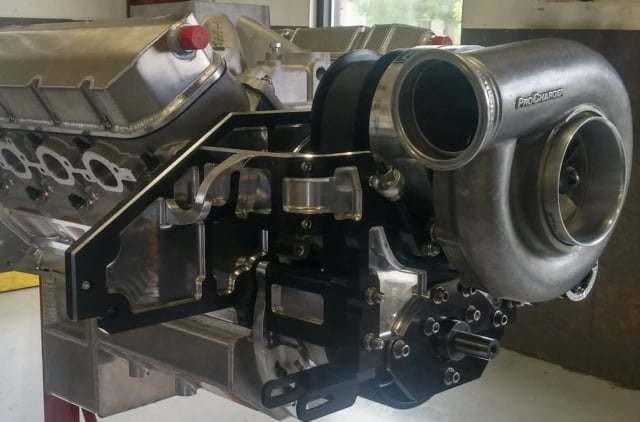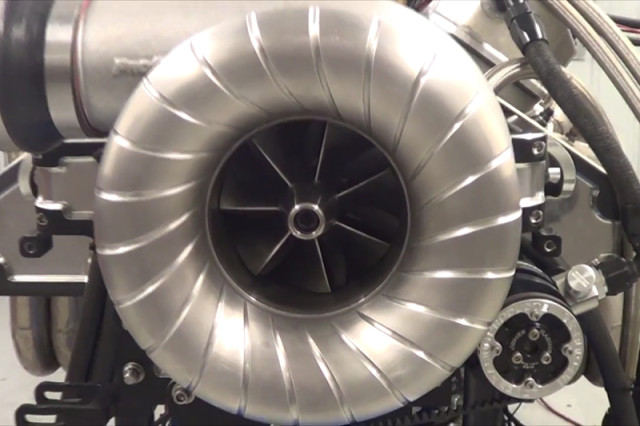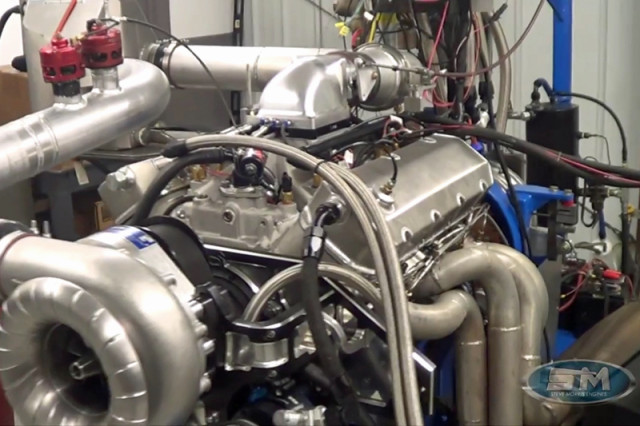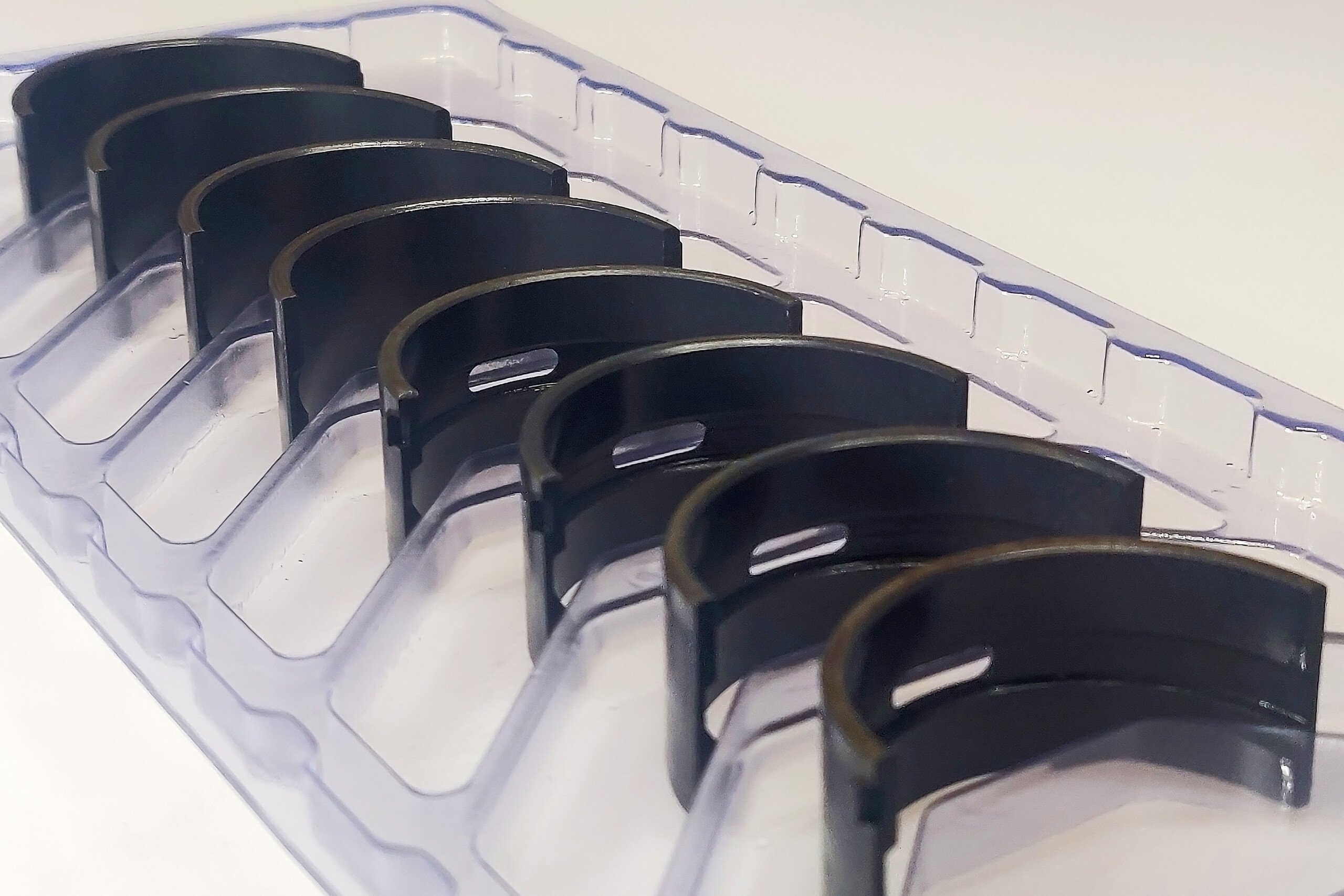Playing with big horsepower engines all day like those found in the engine room and the dyno cell at Steve Morris Engines must be an exhausting task. We kid, we kid. This particular monster big-block Chevrolet engine checks in at a diminutive 540 cubic inches and is stuffed full of the goodies that SME offers its customers; scienced-out crankshafts, connecting rods, pistons, and valvetrain bits that help to create big horsepower as part of the company’s Engine Builder Series of components. Each of the main engine components were purchased from SME by Texas native (and engine owner) Ricky Sehon over the last couple years as he could accumulate the funds.
The engine has been tricked out with a couple of interesting products, most notably the insane computer-modeled, CNC-machined ProCharger bracket hanging the F-3R-136 supercharger off the front of the engine. Turns out that Sehon owns a CNC machining business and developed the trick bracketry in-house.

Check out that wild supercharger bracket, developed by the engine’s owner, Ricky Sehon, at his CNC machining shop.
Also a bit out of the norm for SME’s traditional engine packages is the use of Air Flow Research 385 cc Magnum 24-degree cylinder heads on top. Other notable parts include Holley‘s Dominator EFI system using SME coil-on-plug ignition that’s been tuned in-house at SME to make the power. SME’s also outfitted the supercharger with its ProVolute system. There’s a Moroso vacuum pump system, and a CN billet aluminum engine block anchoring the big-block. Unlike most combinations that SME develops of this nature which use a mechanical fuel pump, Sehon’s engine uses a pair of MagnaFuel Pro Star 750 electric fuel pumps running at 16 volts during the dyno session.
On the initial pulley combination, the engine combination performed exactly as advertised. The power curve — which displays as more of a ramp, not a curve — makes 1,094 horsepower and 1,275 lb-ft by 4,500 rpm. The boosted bullet made 1,500 horsepower and 1,500 lb-ft of torque by 5,500 rpm and continued up from there to 1,898 horsepower at 6,000, 2,158 horsepower at 6,500, and 2,446 horsepower at 7,000 rpm before topping out with 2,669 horsepower and 1,894 lb-ft of torque at 7,400 rpm with 35 psi boost pressure. But that’s not all.

The Morris ProVolute has been tested and proven to add horsepower — check the link in the article for more on this supercharger modification.
“If we build this as our 2,500 horsepower package, that’s where we’ll dyno and tune it at or just slightly above, but if the customer wants to lean on it harder, they will make more horsepower. He asked us to lean on it harder to see what kind of horsepower it would make,” says Morris.
Changing the pulley combination to bring the boost in harder across the RPM range had the desired effect, and it’s here that the engine really starts to sing. The new pulley combination not only permits more boost at the top end, but across the entire powerband. For example, with the mild pulley combination, the engine produced 2.5 psi more boost at 6,000 rpm (21.4 vs. 23.94), 3 psi more at 6,500 rpm (26 vs. 29.04) and 5 psi more at 7,000 rpm (30.17 vs. 35.14 psi) before topping out at 40 psi at the end of the run.

Sehon originally started this project after seeing video of another engine that SME had built for a previous customer. Once he had secured all of his parts, he shipped them to SME for completion and dyno testing.
With the revised pulleys, the additional boost ensured more power at the benchmark numbers as well. At 4,500 rpm, the engine makes 1,158 horsepower (+64 hp), 5,500 rpm brings 1,689 hp (+75 hp), 6,000 shows 2,010 (+112 hp), 6,500 rpm has 2,328 showing (+ 170 hp) and 7,000 rpm shows a gain of 203 horsepower (2,446 hp vs. 2,649 hp).
Perhaps most impressive is the engine’s final power output. Although SME sells the parts and pieces that Sehon used as their 2,500 horsepower package, at Sehon’s request they pushed the envelope, taking the engine up to a whopping 2,861 horsepower and 2,001.5 lb-ft of torque by the end of the session. Check out the video and listen to it wind up the dyno!

















